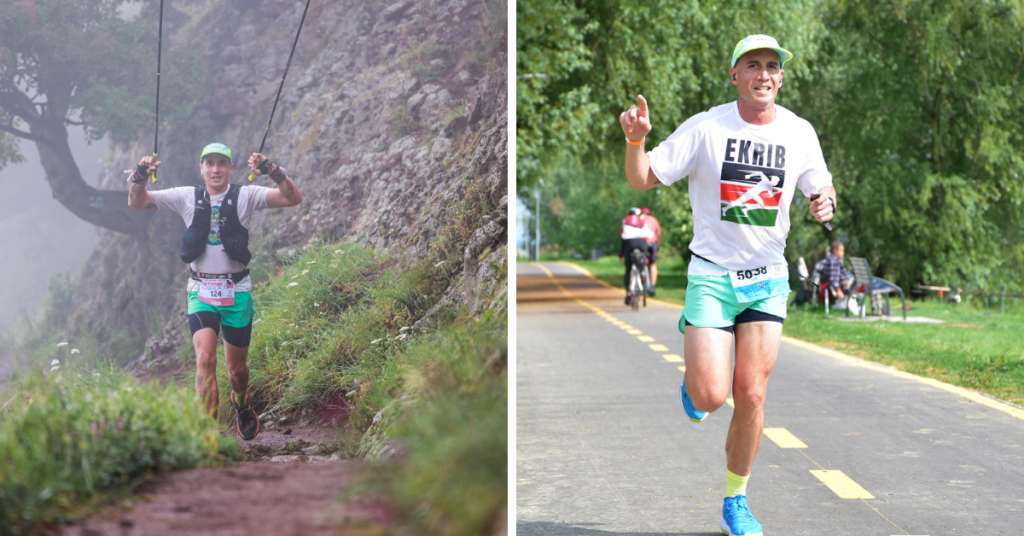Most runners need to understand the why in their training plans, and I can explain that to the runners I coach, but usually, my harshest critic of my plans is myself, especially when it comes to training. Like the old adage, “do as I say, not as I do.” However, this time, I tried to shift this narrative. I was preparing for two vastly different types of races within just two weeks: a fast, flat relay on tarmac where my stages added to 48km in total and a grueling 111km trail ultra with significant elevation gain. The challenge was figuring out how to train effectively for both events. Here’s how I built my 18 week (+2 weeks in between races) plan to achieve this.

The Difference in the Two Races:
Ultra Balaton – 5 Person Relay:
Ultra Balaton Relay is a 211km relay race around Lake Balaton, characterised by flat, tarmac terrain with no trail running. The goal was to complete it as quickly as possible. Our five-person team ran different stages, with some doing four stages and others five. We completed the race in 14 hours, 54 minutes, and 36 seconds. My stages were as follows:
Stage 1: Start time: 11:50am, May 3rd, 2024
- Distance: 8.01km
- Elevation Gain: 59m
- Pace: 3:48/km
- Time: 30:29
Stage 2: Start time: 3:15pm, May 3rd, 2024
- Distance: 7.08km
- Elevation Gain: 3m
- Pace: 3:46/km
- Time: 26:39
Stage 3: Start time: 6:31pm, May 3rd, 2024
- Distance: 14.53km
- Elevation Gain: 8m
- Pace: 3:57/km
- Time: 57:20
Stage 4: Start time: 10:21pm, May 3rd, 2024
- Distance: 10.43km
- Elevation Gain: 88m
- Pace: 4:02/km
- Time: 42:06
Stage 5: Start time: 1:26am, May 4th, 2024
- Distance: 7.54km
- Elevation Gain: 38m
- Pace: 3:56/km
- Time: 29:45
Ultra Trail Hungary:
Ultra Trail Hungary was a solo event covering 111km with 4200m of elevation gain, mostly on trails. The race started at midnight, meaning a significant portion of it was run at night, adding the challenge of sleep deprivation. I completed this race in 14 hours and 27 minutes. You can see my race report here.
- Distance: 111.70km
- Elevation Gain: 4,254m
- Pace: 7:46/km
- Time: 14hrs 27mins


How I Prepared for Two Different Races
To tackle two vastly different races, I adapted a variation of the Lydiard Pyramid approach, which includes phases of Aerobic Base, Hill and Strength, Anaerobic, Integration, and Taper. While sticking perfectly to this method is challenging, I focused heavily on the Aerobic Base phase, understanding its crucial role in building a strong foundation.
Aerobic Base Phase:
I dedicated 9 weeks to building a solid aerobic base, off the back of maintenance miles in late 2023, which involved long, easy runs. Instead of focusing on pace, I concentrated on perceived effort, keeping it low and manageable. During this phase, I consistently ran over 100km per week and included specific strength exercises in the gym to enhance my overall strength. This preparation was crucial for tackling both speed and hill climbs, essential for the Ultra Trail Hungary. I also incorporated Tread-Hill exercises to build climbing strength while minimising stress on my body, ensuring I was ready for the demands of both races.
Skipping Hill and Strength Phase:
Anaerobic Phase:
For four weeks, I introduced speed sessions. Initially, I was concerned that I might have lost my speed due to the extensive base building, but I quickly regained my pace. My interval sessions were successful, and I found myself faster than ever before. This phase prepared me for the fast, flat sections of the Ultra Balaton relay.
Integration Phase:
Taper Phase:
The taper phase lasted about 2 weeks and posed challenges due to my demanding work schedule. I had to travel to Warsaw for a conference I was organising, which meant long hours and limited sleep. Despite the hectic schedule, I prioritised my training and squeezed in a final hard workout 10 days before the Ultra Balaton race. This intense session comprised 10km at a 4:00min/km pace, followed by 4km at 5:00min/km pace, 7km at 3:45/km pace, and another 4km at 5:00/km pace. This rigorous routine left me feeling sharp and prepared for the upcoming taper period.
During the taper, I adjusted my training to include more easy runs and some light hill sessions, focusing on relaxation and recovery leading up to the Ultra Balaton Relay. Additionally, I incorporated a few faster sessions, such as sharpeners and up-tempo runs, to ensure I maintained my speed and readiness for the relay event.
Post First Race Transition:

What I Learnt
Balancing Road and Trail Training:
The Power of Specific Gym Sessions:
Game-Changing Tread-Hill Workouts:
Mental and Physical Resilience:
Prioritising Recovery:

Training for both road and trail races, especially when they are so close together, has been a challenging yet enlightening journey. Balancing the unique demands of each race type required careful planning, adaptability, and a willingness to learn from each experience. Incorporating specific gym sessions and innovative tread-hill workouts has significantly enhanced my performance and resilience, proving the importance of a well-rounded training regimen.
The lessons learnt from this process are invaluable. I’ve come to appreciate the power of strength training, the benefits of strategic hill workouts, and the necessity of prioritising recovery. These insights not only improved my race outcomes but also provided a deeper understanding of how to train more effectively for diverse racing conditions.
As I look ahead, these experiences will shape my future training plans and race strategies. Whether focusing on one type of race or continuing to challenge myself with back-to-back events, I now have a stronger foundation to build upon. Most importantly, I can pass these learnings on to my clients, helping them to navigate their own training journeys and achieve their running goals with greater confidence and success.
So, whether you’re gearing up for your first road race or tackling the rugged trails, remember that every step, every hill, and every recovery day contributes to your growth as a runner. Lace up, embrace the journey, and discover the transformative power of running.


